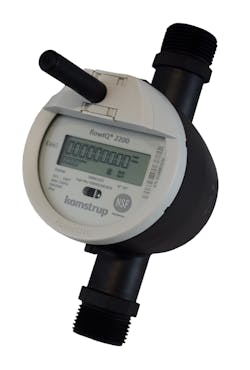Acoustic Leak Detection
When every drop of water counts, finding and accounting for non-revenue water is critical. In this Q&A, WaterWorld spoke about leak detection with Karen Siu, a solution manager, and Anne Lorrigan, a commercial product manager, both with Kamstrup, about the company’s latest acoustic leak detection solution.
WaterWorld: What is Kamstrup’s acoustic leak detection solution?
Karen Siu: Kamstrup’s acoustic leak detection solution begins with our new flowIQ 2200 water meter, leak detection software and services. This builds upon our existing smart meter that uses ultrasonic technology to monitor acoustic noise levels within the water pipe 24/7.
The acoustic data is gathered with every single reading. The utility can leverage that data regardless of the reading system that they use, whether that’s AMR or AMI. So what this means to the utility, [is that] wherever they deploy a smart meter, they’re also getting an acoustic leak sensor. Using the [Kamstrup] software, they can then prioritize where to focus their leak detection efforts, looking at these acoustic noise level trends over time.
WaterWorld: Can you talk about why Kamstrup developed this solution?
Anne Lorrigan: Kamstrup recognizes that non-revenue water is one of the biggest challenges for water utilities worldwide, and in the U.S. it contributes to billions of dollars’ worth of treated water lost.
So that is why we came out with our [acoustic leak detection] solution: to provide an easy and effective means to address water loss. And already, with our ultrasonic meter, we’ve been able to help our existing customers to recover revenue from apparent water losses.
So, those losses [result] from inaccurate measurement of water consumption, but the reality is that the biggest component of non-revenue water is leaks and bursts on service lines and main pipe. So, it was necessary for us to bring something to the table where you can actually detect leaks upstream of the meter.
WaterWorld: What are some of the main advantages of your automatic leak detection solution compared to some other leak detection technologies in the marketplace?
Anne Lorrigan: In our solution, the acoustic sensor is fully integrated into the water meter. So you almost can’t tell the difference between our water meter, the flowIQ 2200, that has [an] integrated acoustic sensor and a regular water meter.
For example, with our flowIQ 2250, there’s almost no difference at all, visually or in size. And the advantage is really that there’s no additional infrastructure to install and maintain, and it also makes it more economically feasible to cover a larger area with acoustic sensors.
Another advantage is that typically today in leak detection practice, the utility will often start looking for leaks in areas where it’s not really known if there’s leaks or not, so potentially valuable resources could be wasted. So with our solution and using the leak detector software, we’re able to prioritize areas for maintenance where you know that leaks are really present.
Karen Siu: [I would] add that Kamstrup’s acoustic leak detection solution allows you to monitor these leaks 24/7 on your service connections, so the utility is able to then prioritize [and] discover these leaks early in the stages before they become a problem.
In addition, Kamstrup provides services, including onboarding training, monitoring, and consulting to help these utilities address these leak detection issues. WW
